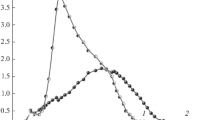Abstract
TG, DTG and simultaneous DTA were used to monitor the thermal decomposition processes of cellulose in nitrogen or in an oxidative atmosphere. Volatile products and solid residues formed during decomposition were analyzed to obtain additional information for elucidation of the thermal curves. An indication of possible flaming or smoldering combustion is discussed. The maximum weight-loss rate, the percentage amount of the residue at the final temperature, and the exothermic peak areas (DTA) could be considered as suitable criteria for the flammability of cellulosics and the activity of flame retardants. The formal kinetic parameters evaluated from the thermogravimetric measurements correspond to the limiting oxigen index (LOI) values. New observations were made using a combination of thermal analysis and LOI techniques. LOI — smoldering or LOI — flaming are mathematically determined from the plot of weight-loss rate versus oxygen concentration.
Zusammenfassung
TG, DTG und simultane DTA wurden zur Verfolgung der thermischen Zersetzungsprozesse von Zellulose in Stickstoff oder in einer oxidativen Atmosphäre eingesetzt. Während der Zersetzung entstandene flüchtige Produkte und feste Rückstände wurden analysiert um weitere Informationen zur Klärung der Kurven zu erhalten. Ein Hinweis auf mögliche flammende oder glühende Verbrennungen wird diskutiert. Die maximale Geschwindigkeit des Gewichtsverlusts, die prozentuale Menge des Rückstandes bei der End-temperatur und die exothermen Peakflächen (DTA) könnten als geeignete Kriterien für die Entflammbarkeit der Zellulosen und die Aktivität der feuerhemmenden Substanzen betrachtet werden. Die aus den thermogravimetrischen Messungen errechneten formalen kinetischen Parameter entsprechen den LOI (limiting oxygen index) Werten. Neue Beobachtungen wurden unter Einsatz einer Kombination der Thermoanalyse und der LOI-Techniken gemacht. LOI-Glut oder LOI-Entflammen werden mathematisch aus dem Zusammenhang zwischen der Geschwindigkeit des Gewichtsverlusts und der Sauerstoffkonzentration bestimmt.
Резюме
ТГ, ДТГ и совмещенный м етод ДТА были использованы для кон троля процессов термического разлож ения целлюлозы в атмо сфере азота и в окислительной атм осфере. Летучие продукты и ос татки, образующиеся в о время разложения, были проа нализированы для получения дополн ительной информации для объяснения термичес ких кривых. Обсуждено ука зание о возможном вос пламенении тлении целлюлозы. Ско рость макимальной потери в еса, процентное колич ество твердого остатка, обр азующегося при конечной температур е разложения, и поверх ности экзотермических пик ов (ДТА), могут-считаться тодходящи ми критериями воспла менимости целлюлоз и активност и замедлителей пламени. Формальные к инетические парамет ры процесса вычислены из термогр авиметрических измерений, соответст венно значениям ЛОИ. О тмечены новые наблюдения при испольвании совм ещенного термическо го анализа и метода ЛОИ. ЛОИ — тлени е и ЛОИ — воспламенение о пределяются математ ически из горафика в координат ах скорость потери веса и концент рация кислорода.
Similar content being viewed by others
References
S. L. Madorsky, Thermal Degradation of Organic Polymers, Intersci N.Y., 1964.
R. F. Schwenker, Proc. of the 2nd ICTA, Div. of Johnson and Johnson, Milltown N. Y. Toronto, 1967, p. 59.
B. Laszkiewicz andH. Struscyk, J. Thermal Anal., 19 (1980) 425.
M. Košik, V. Reiser, V. Lužáková andA. Blažej, Research of Degradative Changes of Polymeric Materials, Internal Report, SVŠT Bratislava, 1980.
L. Matisová-Rychlá, J. Rychly andM. Vavreková, Polym. Degrad. Stab., 2 (1980) 187.
A. Tewarson andR. F. Pion, Combustion Flame, 26 (1976) 85.
F. F. Kollman andT. Topl, J. Fire and Flammability, 2 (1971) 231.
J. Simon, B. Androsits, B. Szalay andS. Lantos, Hung. Sci. Instr., 48 (1980) 1.
W. K. Tang andW. K. Neil, J. Polymer Sci., Part C, 6 (1964) 65.
K. Akita andM. Kase, J. Polymer Sci., Part A, 5 (1967) 833.
M. Košik, V. Lužáková andV. Reiser, Cellul. Chem. Technol., 6 (1972) 589.
F. Shafizadeh, Advan. Carbohyd. Chem., 23 (1968) 418.
F. Shafizadeh, J. Polymer Sci., 36 (1971) 21.
O. Egyed andJ. Simon, J. Thermal Anal., 16 (1979) 277, 321.
F. J. Kilzer andA. Broido, Pyrodynamic, 2 (1965) 151.
M. Košik, Y. Reiser andI. Michlik, Papír a celulóza, 7 (1973) V-29.
C. Cavenaghi andR. Clemente, Proc. of the 4th ICTA, Akadémiai Kiadó, Budapest, 1975, vol. 3, p. 415.
M.Košik, I.Špilda, V.Reiser and A.Blažej, Proc. of 1st Europ. Conference on Flammability, Brussel, 1977, p. 84.
C. Z. Carrol-Porczynski, Composites, 4 (1973) 9.
D.Bakoš, M.Košik, K.Antoš, I.Vyskočil and M.Karolyová, Fire Materials, (1981) (in press).
A. W. Benbow andC. F. Cullis, Combustion Flame, 24 (1975) 217.
J.Simon, T.Kozma and B.Androsits, Proc. of 4th Conference on Nonflammability Polymeric Materials, Bratislava, 1980, I, p. 46.
M. Košik, V. Lužáková, V. Reiser andA. Blažej, Fire Materials, I (1976) 19.
R. M. Perkins, G. L. Drake andW. H. Reeves, J. Appl. Polymer Sci., 10 (1966) 104.
J. E. Hendrix, G. L. Drake andR. H. Barker, J. Appl. Polymer Sci., 16 (1972) 41, 257.
F. L. Browne andW. K. Tang, Fire Res. Abstr. Rev., 4 (1962) 76.
M. Košik et al., Drevársky výskum, 22, 3 (1977) 175; 23, 3 (1978) 169; 23, 3 (1978) 181; 24, (1979) 61.
M. A. Bingham andB. J. Hill, J. Thermal Anal., 7 (1975) 347.
I.Špilda, J.Rychlý, M.Košik, K.Balog and A.Blažej, The Compensation Effect in Flame Retarded Polypropylene, poster presentation, Hungarian Symp. on TA (1981).
J. J.Pitts, Inorganic Flame Retardants and their Mode of Action. In: W. C. Kuryla and A. J. Papa: Flame Retardancy of Polymeric Materials, N.Y. (1973) I, 133.
M. E. Stepniczka andJ. Dipietro, J. Appl. Polymer Sci., 1 (1969) 167.
M. Košik, M. Mičko andR. Domanský, Wood Sci., 1 (1969) 167.
J. W. Lyons, The chemistry and uses of fire retardants, Wiley Interscience, N.Y., 1974.
P. D.Garn and C. L.Denson, Textile Res. J., (1977) 535.
P. D.Garn and C. L.Denson, Textile Res. J., (1977) 485.
D. D. Evans andH. W. Emmons, Fire Research, 1 (1977) 57.
Author information
Authors and Affiliations
Additional information
We wish to express our thanks to Mrs. V. Michliková for her skilful assistance.
Rights and permissions
About this article
Cite this article
Košík, M., Reiser, V. & Blažej, A. Thermoanalytical studies of combustion of cellulosics and activity of fire retardants. Journal of Thermal Analysis 23, 51–64 (1982). https://doi.org/10.1007/BF01908486
Issue Date:
DOI: https://doi.org/10.1007/BF01908486



